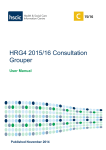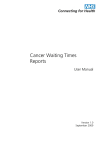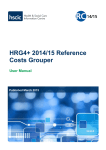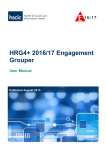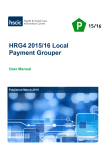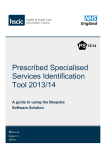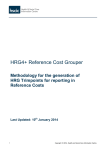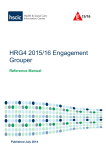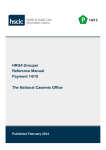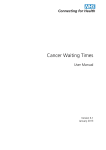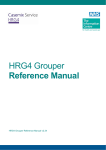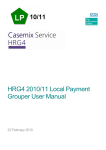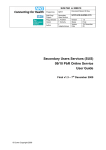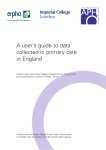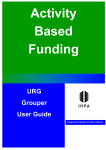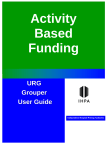Download Guide to File Preparation Document
Transcript
The Casemix Service HRG4 Reference Cost Grouper – Guide to File Preparation Issue Date: 28 April 2008 Page 1 of 18 CONTENTS DICTIONARY AND GLOSSARY ............................................................................................................. 3 1. INTRODUCTION ............................................................................................................................... 4 2. OVERVIEW OF FILE PROCESSING ............................................................................................ 5 3. ADMITTED PATIENT CARE........................................................................................................... 8 4. NON-ADMITTED PATIENTS ........................................................................................................ 14 5. EMERGENCY MEDICINE ............................................................................................................. 16 6. ADULT CRITICAL CARE .............................................................................................................. 17 Page 2 of 18 Dictionary and Glossary The following definitions and abbreviations are provided to assist users to understand some key terms and acronyms. Where definitions are provided they have been stated in a context relating to the use of HRGs (Healthcare Resource Groups). Term CART Casemix classification CC CDS CV DH ERP EWG HRG ICD-10 Iso-resource LOS IC OPCS PbR PCT RIV Expansion/explanation Classification and Regression Trees. Classification of people or treatment episodes into groups, using characteristics associated with the condition, treatment or outcome that can be used to predict need, resource use or outcome. Complications and Comorbidities. Commissioning Data Set. Coefficient of variation – a measure of the amount of variation within a group of values. Department of Health. Expert Reference Panel. Expert Working Group. Healthcare Resource Group – groupings of treatment episodes which are similar in resource use and clinical response. International Classification of Disease and Related Health Problems. Internationally defined classification of disease, managed by the World Health Organisation – 10th Revision. Similar in resource use. Length Of Stay – Duration of the hospital stay from admission to discharge. Information Centre for Health and Social Care The system of codes used to record interventions and procedures. This was originally developed by the Office of Population Censuses and Surveys (superseded by the UK Statistics Authority). Payment by Results. The financial system providing a transparent, rules-based system for paying trusts where payment is linked to activity and adjusted for casemix. Primary Care Trust. Reduction in Variance. This is a measure of how much variation is explained by the HRGs. The aim with HRGs is to maximise the RIV. Page 3 of 18 1. Introduction This document assists users of the HRG4 Reference Cost Grouper (‘the grouper’) in preparing data for processing within the application. Activity data from existing healthcare systems will be prepared and processed as part of the Reference Costs submission to the DH for the year 2007/08. This document identifies the data items required and provides information about the data preparation necessary for successful processing. This document is not intended as a user guide for the grouper. A help file, which gives full instructions, is incorporated into the grouper software package; this can be downloaded from the Casemix website. 1.1. Why is the Reference Cost Grouper Required? The Reference Cost Grouper has been developed to: • • • • • Underpin Payment by Results and support the introduction of HRG4 Prepare data for Reference Costs submission for 2007/08 Provide HRG4 assignment to activity reflecting changes in: a. clinical practice and costs b. introduction of HRGs to new clinical areas c. introduction of ‘setting independence’ Incorporate the introduction of: a. unbundling b. improved complication and comorbidity splits c. improved identification and classification of procedures using updated OPCS codes Enable more accurate analysis of healthcare activity within the service Further information on Payment by Results can be found at: http://www.dh.gov.uk/PolicyAndGuidance/OrganisationPolicy/FinanceAndPlanning/NHSFinancia lReforms/fs/en Although this document contains references to adjustments to be made to data for reference costing, a full description of which records to include in, and exclude from, the DH PbR Reference Costs submission is beyond the scope of this document. Further information on Reference Cost data collection can be found at: http://www.dh.gov.uk/PolicyAndGuidance/OrganisationPolicy/FinanceAndPlanning/NHSReferen ceCostsDataCollection/fs/en Page 4 of 18 2. Overview of File Processing 2.1. Data Input The HRG4 Reference Cost Grouper allows activity data to be processed into standard groupings of clinically similar treatments which use comparable levels of healthcare resource. To achieve this it uses the HRG4 definitions for the following activity types: • Admitted Patient Care • Non-Admitted Patients • Emergency Medicine • Adult Critical Care Because of differences in the way HRG4 definitions are applied to the above activity types and differences in the data required to correctly assign the HRG, the Reference Cost Grouper only processes a data file for a single activity type at one time. The activity type must be specified by the user within the grouper prior to the input data file being processed. This is done by choosing the required definition database file from the drop down list on the main screen at start up. See the grouper help for further details. The software accepts data as a comma-separated text file using the standard ASCII character set. The data items required for the purpose of Reference Costs submission are largely a sub-set of the data items used for recording Hospital Episode Statistics (HES). These in turn are either derived or taken directly from the CDS data file definitions. This should ensure that the data are readily available from sources that are routinely collected. The principal data sources from which data for HRG4 groupings are derived are: • Admitted Patient Care Commissioning data set (CDS) • Outpatient Attendance CDS • Accident and Emergency CDS (for Emergency and Urgent Care HRGs) • Adult Critical Care Minimum Data Set (MDS) These data are already recorded in many existing Patient Administration Systems (PAS); however, it is likely that data required to support the derivation of HRGs for Chemotherapy and Radiotherapy treatments are not currently being captured in a local PAS. Where these data are only collected in specialist departmental systems, local arrangements will be needed to ensure that the data can be incorporated into admitted care or outpatient datasets for HRG grouping following the guidance in the relevant chapter below. Page 5 of 18 2.2. Data Preparation The data items required differ for each activity type and extracts from each proprietary PAS may also differ. It is therefore difficult to fully automate the data input process without some user intervention in the form of data preparation. This is covered in more detail for each activity data type in the chapters below. In general, the user must provide the Reference Cost Grouper with information regarding which data item in their own input file maps to the required data field for the relevant activity type definition file. The software achieves this by using a Record Definition File (RDF) to interpret the input data file. This cross references each of the required activity data fields to the mapped field position within the user’s data file. 2.3. Data Validation In order to accurately assign an HRG to activity data, the software will ensure that the data are complete, valid and within expected value ranges. The software will apply three stages of validation to the data during a processing run. The three stages are: • Field content within record • Cross validation of episodes within spell • Grouping Logic (assignment of flag values) Where the Reference Cost Grouper has not been able to resolve the assignment of an HRG definition to the data contained in an input record, a code of UZ01Z is returned in the output record signifying that the data is invalid for grouping. If there are errors in the input data these will be reported in the Data Quality Report but processing will not be halted. There can be more than one reason why the assignment was not resolved and so this report may contain several records, all of which need to be reviewed to identify the underlying problems. In order to relate invalid records to source systems it may be valuable to add a unique key field to each record. 2.4. Approaches and Sites Within the HRG4 definitions there are instances where the assignment of an HRG to a procedure code is dependent on the presence of other codes, indicating either the approach that was taken or the site of treatment. Such codes should always be subsequent to the procedure to which they refer - this should be taken to mean ‘after and adjacent to’, unless otherwise specifically stated. Page 6 of 18 Care should be taken that coding practice reflects this; the software will not apply a single site code to a group of procedures, and neither will it apply an approach code at the end of a record to all of the procedures in that record. Site codes and approach codes are only applied to the procedure that directly precedes them in the input record. An example is given below: Episode No 1 2 3 Primary Procedure J104 J106 J106 Procedure 2 Procedure 3 Procedure 4 Z393 J104 Z393 J118 Z393 J104 Z393 In the above record sequence it should be noted that in episode no. 2 the site recorded as Z393 “Portal vein” is taken to refer only to the J104 angioplasty procedure and is not applied to the J106 thrombolysis procedure. If both procedures are performed on the portal vein then the record must be recorded as shown in episode no. 3. 2.5. Data Output Given a correctly configured RDF and user data file, then the software package can process the data against the chosen HRG4 definitions. The assigned core HRG and any additional information is appended to each record and this is output as a flat file in CSV format with quoted alphanumeric fields. This will allow ease of import into MS Excel, Access or other applications. The filename and location can be chosen using the Process File dialog box. The output file will have the following features: • A single output row for each row from the input file. • Each column of the input file will be output in the same location in the output file. • The relevant grouping and activity analysis data will be appended to the end of each record. The data to be appended is specific to each activity type and is covered in the relevant chapters below. Page 7 of 18 3. Admitted Patient Care 3.1. Overview Table 1 below shows the data items required by the Reference Cost Grouper. Table 1. Field Name Grouper Description Format Validation PROCODET Organisation Code text Not Null PROVSPNO Hospital Provider Spell Number text Not Null Local Spell Identifier EPIORDER Episode Number number File must be ordered by PROCODE, PROVSPNO and EPIORDER STARTAGE StartAge number SEX Sex text CLASSPAT Patient Classification number ADMISORC Source Of Admission (Hospital Provider Spell) text ADMIMETH Admission Method (Hospital Provider Spell) text DISDEST Discharge Destination (Hospital Provider Spell) text DISMETH Discharge Method (Hospital Provider Spell) text number text 1 – 87. Distinct within Provider Spell. 0 – 130. Increase between episodes relative to episode duration. 0,1,2 or 9. Identical value for all episodes within Provider Spell. Not Null Not Null. Identical value for all episodes within Provider Spell. Not Null. Identical value for all episodes within Provider Spell. Not Null. Identical value for all episodes within Provider Spell. Not Null. Identical for all episodes within Provider Spell. 0-99999 Not Null text Not Null text Not Null text Null or valid OPCS Code without decimal point. EPIDUR MAINSPEF TRETSPEF Episode Duration Main Specialty Code Treatment Function Code NEOCARE Neonatal Level of Care OPER_01 Primary Procedure (OPCS) Page 8 of 18 Notes / Derivation Local provider code possibly the NACS code (an(5)) Start Date(Episode) - Person Birth Date (integer whole years) Must be a valid national code Must be a valid national code Must be a valid national code Must be a valid national code Must be a valid national code Must be a valid national code Whole days Must be a valid national code Must be a valid national code Must be a valid national code (0 if not relevant) Dots are not accepted. For example, use F343 rather than F34.3. See note at foot of table. OPER_02 - 12 Additional procedures text DIAG_01 Primary Diagnosis (ICD) text DIAG_02 - 14 Additional diagnoses text As above. Not Null. Valid ICD code excluding decimal point character and any dagger/asterisk characters. Null or valid ICD10 Code Dots are not accepted and any dagger/asterisk codes must be removed. For example, use A170 rather than A17.0† or A17.0D. See above. Number of Critical Care days. Blank or zero where the user has already removed Critical CRITICALCAREDAYS CRITICALCAREDAYS Number Care days from the data or where there are no Critical Care days. Note: the Record Definition File ‘extract’ facility can be used to remove decimal points from clinical codes during file processing. See the grouper user manual for details. Blank or 0-99999. Non-numeric characters treated as zero. 3.2. Record Preparation Organisation Code This data item can be any code used locally to identify the organisation. We recommend using the three or five character NACS code. Hospital Provider Spell Number and Episode Number The Reference Cost Grouper provides data output based on HRGs assigned at both an Episode and Spell level. It is not necessary to sort the data before processing; the grouper sorts the data automatically during processing. All records are treated as Finished Consultant Episodes (FCEs). It is the user’s responsibility to ensure that the data file contains only those records required for the purpose of Reference Costs submission. Where the source data does not include data items which are directly equivalent to Hospital Provider Spell Number and Episode Number (or they cannot be extracted from the source systems) then some form of proxy must be included in these fields within the submitted file. For Episode Number a simple incremental count may be used. There are several ways to create a proxy to spell number, examples are: 1. Concatenate local patient identifier, Admission Date and Admission Time to create a proxy spell number. Important: When concatenating data, do not include any spaces Page 9 of 18 between data items. Admission Time is suggested in order to identify separate spells starting on the same date. 2. Where unique episode identifiers are assigned then use the first episode identifier within the spell as the spell number. StartAge This is the patient’s age at the start of the consultant episode. The calculation is: Start Date (Episode) – patient’s date of birth The age should be an integer value of whole years rounded down. Age is required as a determinant for several HRG assignments the validation procedures will return a UZ01Z code where age is not present or where it is not a value between 0 and 130. The user must therefore extract the correct data from their source data files and calculate the age value for each record of the data input file. N.B. the validation process will check each FCE record and will not accept the AGE field appearing only within the initial FCE of a Spell. Sex Sex can be a value 0, 1, 2, 9 as per ISO 5218. However, where sex is a determinant of the HRG then sex must be a value either 1 or 2 indicating male or female for the correct HRG to be assigned. Patient Classification Patient Classification must be a value 1, 2, 3, 4 or 5 as per the national codes. It must be the same value for all episodes within a Hospital Provider Spell. Source of Admission (Hospital Provider Spell) This is the national code for the source of admission for the Hospital Provider Spell. The Reference Cost Grouper will check all of the episodes within a spell in order from the earliest FCE forward. It will take the first available value from this field and validate it against the national codes. The software will ignore null values, but users should be aware that a value outside of the national codes will cause a UZ01Z code to be assigned as the core HRG. Admission Method (Hospital Provider Spell) This is the national code for the method of admission for the Hospital Provider Spell. The Reference Cost Grouper will check all of the episodes within a spell in order from the earliest FCE forward. It will take the first available value from this field and validate it against the Page 10 of 18 national codes. The software will ignore null values, but users should be aware that a value outside of the national codes will cause a UZ01Z code to be assigned as the core HRG. Discharge Destination (Hospital Provider Spell) For finished spells only, this is the national code for the discharge destination. The Reference Cost Grouper will obtain the value of this field from the last episode in the spell and validate it against the national codes. A value outside of the national codes will cause a UZ01Z code to be assigned as the core HRG. Discharge Method (Hospital Provider Spell) For finished spells only, this is the national code for the discharge method of the patient. The Reference Cost Grouper will obtain the value of this field from the last episode in the spell and validate it against the national codes. A value outside of the national codes will cause a UZ01Z code to be assigned as the core HRG. Episode Duration This is a derived data item which the user must calculate prior to the record being submitted to the Reference Cost Grouper. The basic calculation is: End Date(Episode) – Start Date(Episode) To avoid double counting for reference costs submission purposes, both critical care and rehabilitation activity should be subtracted from the Episode and Spell Duration. To Exclude Adult Critical Care Activity: For the purpose of Reference Costs, subtract from the Episode Duration the number of days within the FCE that the patient has spent in Adult Critical Care. It is possible for either the Critical Care Start Date or the Critical Care Discharge Date to be different from the Episode Start Date or the Episode End Date so care must be taken in calculating how many days within the FCE have been spent in critical care. The calculation for the number of critical care days is: (The earlier of CC Discharge Date or End Date (Episode)) – (the later of CC Start Date or Start Date (Episode)) N.B. Episode Duration should be returned as the number of whole days, rounded down. However, where this would give zero or a negative figure then Episode Duration should be recorded as 1 (one) day. Page 11 of 18 Automatic Exclusion of Adult Critical Care Days The grouper application provides a facility to remove critical care days as part of the grouping process. To use this facility, the input field CRITICALCAREDAYS for each FCE record should be populated with the number of Adult Critical Care days that are to be removed from that FCE. If Adult Critical Care days have already been removed from the data or there are no Adult Critical Care days to be removed, the input field CRITICALCAREDAYS should either be left blank or populated with zeroes. Treatment of Rehabilitation and/or Specialist Palliative Care Activity To avoid double counting activity, episode and spell duration should be adjusted for Rehabilitation and Specialist Palliative Care following grouping. This is because Rehabilitation and Specialist Palliative Care admitted patient activity will generate unbundled per diem HRGs assuming accurate recording of classification codes. Care should be taken to ensure that the HRGs for the core care do not change in line with the adjusted episode and spell duration. Main Specialty Code This is the main specialty in which the consultant is contracted or recognised, it should be a valid code from the Main Specialty Codes table. Treatment Function Code This is the treatment function under which the patient is treated. It may be the same as the main specialty code or it may be a valid code from the Treatment Function Codes table. Neonatal Level of Care Neonatal Level of Care is used by the HRG4 Reference Cost Grouper to allocate the HRG for Neonatal Critical Care Retrieval (XA06Z). When a patient is not neonatal, a value of 0 should be supplied, even for adults. Primary Procedure The grouper application relies on interventions and procedures being recorded as OPCS codes. Page 12 of 18 Additional Procedures Some of the grouper processing uses predefined combinations of codes to simplify the processing logic. These may be combinations of procedure codes referring to approaches used, or the site to which the procedure was applied. These should be recorded as OPCS codes. The grouper application will take all of the procedure codes into account when assigning HRGs. Primary Diagnosis This is the clinical classification of the patient’s diagnosis; the Reference Cost Grouper only recognises the ICD-10 coding system. Additional Diagnoses Where the Reference Cost Grouper cannot assign an HRG based on the procedures within an FCE record, it will attempt to assign an HRG based on diagnosis. In doing so it only takes the primary diagnosis and the secondary diagnosis in the most significant position into account. However, some HRG assignments based on procedure codes are dependent on the diagnosis recorded and in some instances the position of the diagnosis within the record is irrelevant. The Reference Cost Grouper therefore accepts all of the diagnoses codes recorded in the CDS record. 3.3. File Preparation The Reference Cost Grouper will process all records in the data input file and treat them as FCE records. It will treat all records with identical values for the Organisation Code and Hospital Provider Spell Number as belonging to the same Spell and will perform spell based processes on the total content. Page 13 of 18 Non-Admitted Patients 3.4. Overview Table 2 below shows the data items required by the Reference Cost Grouper for Non-admitted Patients, i.e. outpatient attendances or attendances by patients for nursing care on a ward (ward attenders). Since April 1st 2005 the data source for both of these has been the Outpatient Attendance CDS. Table 2. Field Name Description Format Validation AGE Age number 0 - 130 SEX Sex Main Specialty Code Treatment Function Code First Attendance Primary Procedure (OPCS) Additional procedures text 0,1,2 or 9 Notes / Derivation Appointment Date - Person Birth Date (integer whole years) Must be a valid national code text Not Null Must be a valid national code text Not Null Must be a valid national code text Not Null text Null or valid OPCS Code Must be a valid national code Dots are not accepted. For example, use F343 rather than F34.3. text Null or valid OPCS Code MAINSPEF TRETSPEF FIRSTATT OPER_01 OPER_02 - 12 See above. 3.5. Record Preparation Age This is the patient’s age at the time of the attendance. It is therefore: Attendance Date – Birth Date The user must therefore extract the patient’s Birth Date from their source data, calculate the age value and place it in each record of the data input file. The age should be an integer value of whole years (rounded down). Age is required as a determinant for several HRG assignments. The validation procedures will therefore return a UZ01Z code if age is not present or is not a value between 0 and 130. Sex Sex can be a value 0, 1, 2, 9 as per ISO 5218. However, where sex is a determinant of the HRG then sex must be a value either 1 or 2 indicating male or female for the correct HRG to be assigned. Page 14 of 18 Main Specialty Code This is the main specialty in which the consultant is contracted or recognised, it should be a valid code from the Main Specialty Codes table. Treatment Function Code This is the treatment function under which the patient is treated. It may be the same as the main specialty code or it may be a valid code from the Treatment Function Codes table. First Attendance An indicator for whether the patient was making a first or follow-up attendance and whether this was a face to face contact or telephone/telemedicine consultation. Primary Procedure The grouper application requires any interventions and procedures to be recorded as OPCS codes. Where no OPCS codes are recorded the grouper logic will assign an HRG based on the value in the first attendance. Additional Procedures Some of the grouper processing uses predefined combinations of codes to simplify the processing logic. These may be combinations of procedure codes referring to approaches used, or the site to which the procedure was applied. These should be recorded as OPCS codes. The grouper application will take all of the procedure codes into account when assigning HRGs. 3.6. File Preparation The Reference Cost Grouper processes the data items shown above and if a meaningful HRG cannot be assigned a code of UZ01Z is returned signifying that the data is invalid for grouping. In order to relate invalid records to source systems it may be valuable to add a unique key field to each record. Page 15 of 18 4. Emergency Medicine 4.1. Overview Table 3 below shows the data items required by the Reference Cost Grouper. Table 3 Grouper Name INV_01 INV_02 TREAT_01 TREAT_02 Grouper Desc Format Accident And Emergency Investigation First Accident And Emergency Investigation Second Accident And Emergency Treatment First Accident And Emergency Treatment Second an(2) an(2) an(3) an(3) Validation Null or valid code. Null or valid code. Null or valid code. Null or valid code. Desc / Derivation Valid national code Valid national code Valid national code Valid national code Please note that validation permits records where all fields are null; such records should be avoided as default codes will be assumed by the grouper. 4.2. Record Preparation The A&E Attendance CDS allows first and second investigations and first and second treatments to be recorded and so the application requires that all 4 fields are present and populated with either a valid national code or null. Within the A&E Attendance CDS, the investigation fields can contain up to six alpha numeric characters. However, only the two leading characters are the national code, the last four positions being taken up by locally assigned values. These fields must be truncated to the two leftmost characters prior to submitting the data input file. Within the A&E Attendance CDS, the treatment fields can contain up to six alpha numeric characters. Only the three leading characters are the national code, the last three positions being taken up by locally assigned values. These fields must be truncated to the three leftmost characters prior to submitting the data input file. 4.3. File Preparation The Reference Cost Grouper processes the data items shown above and if a meaningful HRG cannot be assigned, a code of UZ01Z is returned signifying that the data is invalid for grouping. In order to relate invalid records to source systems it may be valuable to add a unique key field to each record. Page 16 of 18 5. Adult Critical Care 5.1. Overview Table 4 below shows the data items required by the Reference Cost Grouper. Table 4 Field Name Description Format Validation Notes / Derivation CCUF Critical Care Unit Function Code text Not null valid code for adult must be supplied number 0 - 99999 number 0 - 99999 number 0 - 99999 number number number number number number 0 - 99999 0 - 99999 0 - 99999 0 - 99999 0 - 99999 0 - 99999 ARSD BRSD ACSD BCSD RSD NSD DSD CCL2D CCL3D Advanced Respiratory Support Days Basic Respiratory Support Days Advanced Cardiovascular Support Days Basic Cardiovascular Support Days Renal Support Days Neurological Support Days Dermatological Support Days Critical Care Level 2 Days Critical Care Level 3 Days N.B. Critical Care Start Date and Critical Care Discharge Date fields are no longer used in assigning activity to an HRG. The inclusion of additional fields that help relate records to other systems may be valuable (e.g. to link the critical care record back to the appropriate admitted care episode). The following fields, where available, may be considered for inclusion: Field Name Description Format Validation PROCODET Organisation Code text n/a PROVSPNO Hospital Provider Spell Number text n/a EPIORDER Episode Number number n/a Notes / Derivation Local provider code possibly the NACS code (an(3)) Local Spell Identifier 5.2. Record Preparation A full description of how Adult Critical Care records should be prepared for Reference Costs submission is beyond the scope of this document. Further information is available in the ‘Critical Care Minimum Dataset Training Pack’ available from: http://www.icservices.nhs.uk/casemix/pages/downloads/ Page 17 of 18 5.3. File Preparation The Reference Cost Grouper processes the data items shown above and if a meaningful HRG cannot be assigned a code of UZ01Z is returned signifying that the data is invalid for grouping. In order to relate invalid records to source systems it may be valuable to add a unique key field to each record. Page 18 of 18


















